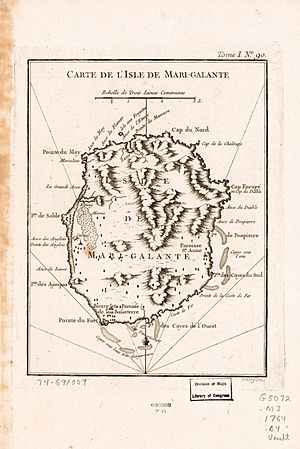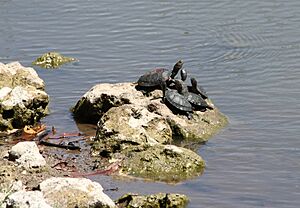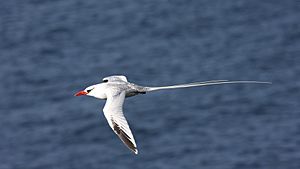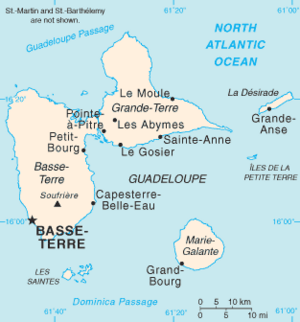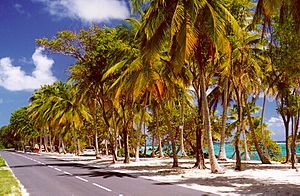Marie-Galante facts for kids
|
Native name:
Marie-Galante
|
|
|---|---|
| Lua error in Module:Location_map at line 420: attempt to index field 'wikibase' (a nil value). | |
| Geography | |
| Location | Caribbean Sea |
| Area | 158.1 km2 (61.0 sq mi) |
| Highest elevation | 204 m (669 ft) |
| Highest point | Morne Constant |
| Administration | |
|
France
|
|
| Demographics | |
| Population | 10867 (2016) |
| Additional information | |
| Time zone | |
Marie-Galante (called Mawigalant in Antillean Creole) is a beautiful island that is part of Guadeloupe. Guadeloupe is an overseas department of France. Marie-Galante covers an area of about 158 square kilometers (61 square miles). In early 2018, about 10,655 people lived there.
Contents
Island Administration
Marie-Galante is split into three main areas called communes. These areas are:
- Grand-Bourg (with about 5,564 people in 2013)
- Capesterre-de-Marie-Galante (with about 3,389 people)
- Saint-Louis (with about 2,575 people)
These three communes joined together in 1994 to form the Community of Communes of Marie-Galante. This was the very first group of its kind in France's overseas regions.
Island History
The first people known to live on Marie-Galante were the Huecoids. After them came the Arawaks, and then the Island Caribs around 850 AD. The Caribs called the island Aichi, and the Arawaks called it Touloukaera.
European Exploration and Settlement
Christopher Columbus discovered Marie-Galante on November 3, 1493, during his second trip. He named the island after his flagship, the Marigalante, which means 'gallant Mary'. Both Marie-Galante and the first island he found, La Deseada, were claimed by Spain.
In 1648, France began to settle the island. About 50 Frenchmen lived near a place called 'Vieux Fort'. However, the tough conditions and attacks from the Carib Indians made it hard for them to stay.
Sugar Plantations and Enslavement
Sugarcane was brought to the West Indies by Christopher Columbus. By 1654, it was grown in Guadeloupe by settlers from Brazil. They built small mills to crush the cane.
In 1660, a peace treaty was signed with the Caribs. This allowed the French and British to settle on nearby islands. With peace, the island's economy grew, focusing on sugar plantations. Sadly, this also led to the forced transport of enslaved Africans to work on these plantations. By 1671, more than half of the island's people were Black.
Over the years, the island faced many attacks from the Dutch and British. These attacks destroyed mills and caused people to leave. The British even took over the island from 1759 to 1763.
Windmills started to appear in 1780. By 1830, there were 105 mills, though many still used oxen. Today, 72 old mill towers can still be seen.
End of Enslavement and Modern Times
The forced enslavement of Africans was first ended in 1794. However, it was brought back in 1802. The British captured Marie-Galante again in 1808 but returned it to France in 1815. Finally, in 1848, the enslavement of Africans was completely abolished. This was thanks to people like Victor Schœlcher and many revolts by enslaved Africans.
In 1849, former enslaved Africans were allowed to vote for the first time. However, rich plantation owners tried to rig the votes. This led to violent protests, and many Black people were killed. Rum and sugar were even dumped into a pond, which is now called la mare au punch ('the Punch Pond').
Since 1946, Marie-Galante and the other islands of Guadeloupe have been an overseas department of France. In 2007, some islands like Saint-Martin became politically separate.
In 1982, a man named Steven Callahan was found alive off Marie-Galante. He had been lost at sea in a small raft for 76 days! Local fishermen rescued him.
Island Geography
Marie-Galante is often called la grande galette ('the Big Biscuit') because it is round and mostly flat. Its highest point is Morne Constant Hill, which is 204 meters (669 feet) high. The island is also known as "the Island of a Hundred Windmills" because it once had over 106 sugar mills.
The northern coast has tall cliffs. A natural fault line, called "the Bar," divides the northern part of the island. On the west side, you'll find beaches and mangroves along the Caribbean Sea. Rivers like the Saint-Louis and Vieux-Fort flow through the island's center. The eastern and southern parts have plains that meet the Atlantic Ocean, protected by a coral reef.
Island Location
Marie-Galante is in the northern part of the world, within the Caribbean (or Antilles) islands. It is about 6,200 kilometers (3,850 miles) from mainland France. It's also about 2,200 kilometers (1,370 miles) southeast of Florida.
Island Climate
Marie-Galante has a tropical climate. This means it's warm all year round. The weather is made milder by the ocean and steady winds called trade winds.
There are two main seasons:
- A dry season from January to June, called carême.
- A wet season from July to December, called hivernage.
The average temperature is about 27°C (81°F). The ocean water is usually around 28°C (82°F). Marie-Galante can sometimes have dry spells. From May to November, the island can experience hurricanes. These storms form in the Atlantic and are carried by the trade winds.
Island Landscape and Environment
The northern part of Marie-Galante has tall limestone cliffs. In the east and south, the land slopes down to a coastal plain. This plain is protected from the Atlantic Ocean by a barrier reef. On the western side, there are beaches and mangroves along the Caribbean Sea.
Marie-Galante is a special place for biodiversity. Many unique plants and animals live here because the island has been isolated for millions of years. Before Europeans arrived, the island was covered in forests. However, new species brought by humans and the clearing of land have greatly impacted the natural environment.
Today, the island's natural areas are affected by less forest cover and more development. Sugar cane farming has also changed the landscape. Efforts are being made to make farming more "sustainable" and protect the island's future.
Island Animals and Plants
On Marie-Galante, you can find different reptiles. These include the red-footed tortoise and a type of gecko called mabouia. Small lizards called anolis are also common.
Some sea turtles come to the island's beaches to lay their eggs. A type of crab called touloulou is also quite common.
Underwater, there's a coral bank about 20 meters (65 feet) deep on the west side. Seagrass beds also grow on the sandy ocean floor near the coast.
Protecting the Environment
Most of Marie-Galante's mangroves have disappeared, but one remains in Vieux-Fort. Human activities have harmed some of the island's natural animal and plant life. However, the western and northwestern parts of the island still have healthy coral reefs with many marine species.
Since 1992, Marie-Galante has been part of the biosphere reserve of the Guadeloupe archipelago. This means it's a special area where nature is protected. Guadeloupe has many protected areas, including a national park.
Important Bird Area
A 14-kilometer (8.7-mile) stretch of Marie-Galante's northern coastline is an Important Bird Area (IBA). This area has high cliffs and a flat islet called Vieux Fort. Many seabirds come here to breed. These include red-billed tropicbirds, brown noddies, and bridled terns. Audubon's shearwaters have also been seen here.
Natural Risks
Marie-Galante faces several natural dangers. These include earthquakes, tsunamis, volcanic eruptions, and tropical cyclones.
Earthquakes and Tsunamis
On November 21, 2004, a strong earthquake hit Marie-Galante and Guadeloupe. It measured 6.3 on the Richter scale. Another earthquake, measuring between 6.8 and 7.3, shook the islands on November 29, 2007. While strong, it did not cause much damage in Marie-Galante.
The earthquake of February 8, 1843, was the most powerful known. It killed over a thousand people and caused huge damage.
Volcanic Eruptions
La Soufrière is a large volcano located on the island of Basse-Terre, which is also part of Guadeloupe.
Tropical Cyclones and Storm Surges
The Caribbean islands are often in the path of tropical hurricanes. Marie-Galante is in a very exposed area and faces many cyclones from May to November.
One of the deadliest hurricanes was the Pointe-à-Pitre hurricane of 1776, which killed at least 6,000 people. In 1989, Hurricane Hugo caused a lot of damage. In 1995, three cyclones hit the islands in less than three weeks.
In September 2017, Marie-Galante faced Hurricane Maria, a very powerful storm. It caused four deaths in Guadeloupe and had winds up to 215 km/h (134 mph). After Hurricane Maria, many people from Dominica came to Marie-Galante for safety. The island also saw people from St. Martin after Hurricane Irma, which was one of the strongest hurricanes in the North Atlantic.
Some other major hurricanes that hit Guadeloupe and its islands include:
- September 12, 1928: Hurricane Okeechobee
- August 11, 1956: Hurricane Betsy
- August 22, 1964: Hurricane Cleo
- September 27, 1966: Hurricane Inez
- September 16–17, 1989: Hurricane Hugo
- September 14–15, 1995: Hurricane Marilyn
- September 6, 2017: Hurricane Irma
- September 18 and 19, 2017: Hurricane Maria
Island Economy
In the past, Marie-Galante's economy relied on growing tobacco, indigo, coffee, and cotton. But from the 17th century, sugar cane became the most important crop. This continued even after the end of enslavement and during sugar crises.
Marie-Galante was known as "the island with a hundred mills" because of its sugar cane industry. In 1818, there were over one hundred mills to process sugar cane. The cane juice was turned into sugar or rum. At first, oxen powered the mills, then windmills from 1780, and later steam-powered mills from 1883.
By the 19th century, the old economic system changed. Smaller sugar refineries were replaced by larger factories. By 1885, five big sites controlled the industry. In 1931, there were eighteen sugar distilleries and four factories.
Today, only one sugar refinery (usine de Grande-Anse) and three distilleries (Bellevue, Bielle, and Poisson) remain. The white rum they make has a special protected name (appellation d'origine contrôlée).
Marie-Galante's rich history and old economy are now tourist attractions. A nature trail with 70 points of interest, including restored windmills and old sugar refineries, helps visitors explore the island.
Tourism is growing on the island, focusing on protecting nature and history. Marie-Galante Airport helps people get to the island, but it's not served by many airlines.
Island Population
In 1946, Marie-Galante had 30,000 people. However, many residents moved to Guadeloupe and mainland France. By 2006, the population dropped to 12,009, and by early 2018, it was about 10,655. This decline is linked to the decrease in the sugar cane industry.
Education on the Island
Marie-Galante is part of the Academy of Guadeloupe, which manages education. The island has:
- Several elementary schools, including a private school.
- Three collèges (which are like junior high schools).
- The Lycée Hyacinthe-Bastaraud (a high school). This high school has special programs, like a class to prepare for the National Merchant Navy School.
Island Health Services
Marie-Galante has:
- A hospital called Centre Hospitalier Sainte-Marie in Grand-Bourg.
- A clinic in the same location.
- A home hospitalization service that started in 2017.
Island Government
Administrative Structure
Marie-Galante is made up of three municipalities: Capesterre-de-Marie-Galante, Grand-Bourg (the main town), and Saint-Louis-de-Marie-Galante. These are all part of the Community of Communes of Marie-Galante (C.C.M.G).
Marie-Galante is currently part of the Pointe-à-Pitre district. Before 2014, the island had three cantons, but since 2015, it has only one canton: Marie-Galante.
Political History
Since the start of French colonization, Marie-Galante has been linked to the Pointe-à-Pitre district. The only exception was during a short period in 1793–1794. During that time, Marie-Galante was a republic, while the rest of Guadeloupe was still loyal to the monarchy.
Marie-Galante Country
The term "Country" (Pays in French) is sometimes used to describe the special and traditional features of Marie-Galante. This term helps to show the island's unique identity and diverse culture.
Island Transport
The island has an airfield, but no regular airlines fly there. To get to other islands like Guadeloupe or Dominica, people travel by boat.
Two main ferry companies, Valferry and Island Express, offer daily trips between Grand-Bourg, Saint-Louis, and Pointe-à-Pitre. The boat trip takes about one hour.
Large barges also bring goods to the island's seaport of Folle Anse. These goods come from mainland France, Europe, and other parts of America.
On the island, you can use all common vehicles. Buses connect the three municipalities daily. There are also taxis and places to rent cars and scooters.
Island Energy
The municipality of Saint-Louis is working on an experimental photovoltaic plant project, which uses solar power.
A wind farm is located in Capesterre, on Morne Constant. This is the windiest spot on the island. It has twenty-three wind turbines that help the island produce its own energy, reducing its reliance on fossil fuels.
In 2017, most of the island's electricity came from fossil fuel power plants in Guadeloupe, brought in by a submarine cable. However, leaders in Marie-Galante want the island to be 100% powered by local renewable energy. They also want to encourage the use of electric vehicles.
A 7.5 MW biomass power plant will be built. It will use bagasse (leftover sugar cane) and household waste for fuel. There will also be more solar and wind power, plus a way to store electricity. This will help Marie-Galante become energy independent.
Island Sports
The Grand-Bourg municipal stadium is used by the US Grand-Bourg soccer club for training and matches. Cycling is popular, with a club called Union vélocipédique marie-galantaise (UVMG).
The Saint-Louis de Marie-Galante municipal stadium hosts the Saint-Louis Athlétic Club (SLAC) soccer team. Since 2020, a three-day jet ski race, called the "Karujet," has been held in Saint-Louis.
The city of Capesterre also has a stadium called Stade José Bade, which can hold at least 1,200 people. It is home to two soccer clubs:
- Club Amical de Marie-Galante
- Jeunesse-Sportive de Capesterre
Sports Groups and Events
- UVMG (Union Vélocipédique marie-galantaise) - Cycling club
- Amical Club de Marie-Galante - Soccer club
- JSC (Jeunesse-Sportive de Capesterre) - Soccer club
- USGB (Union Sportive de Grand-Bourg) - Soccer club
- CMGVB (Comité de Marie-Galante du Volley Ball) - Volleyball club. Leslie Turiaf, a famous volleyball player, is from Marie-Galante.
Sporting events include:
- The Tour of Marie-Galante Cycling Tour.
- The Karujet - World Jet Ski Championship, which includes Marie-Galante.
Island Culture
Traditional Food
Marie-Galante's traditional dish is called bébélé. Another local treat is kilibibi. The caca-bœuf is a type of pastry also enjoyed on the island.
Festivities and Celebrations
At Christmas, families and friends gather for chanté nowel and the Christmas Market. This is a time to sing carols and celebrate.
Carnival troupes parade through the streets every Sunday afternoon from January until the main festivities in February or March. A big carnival parade called WOY MI MASS is held in Grand-Bourg each year. It brings together thousands of people and many carnival groups. They compete for the best costumes, music, and choreography.
There is also the Carnival in kabwèt of Marie-Galante. This tradition mixes French customs with Carnival parades. It features about thirty decorated wagons pulled by oxen. Since 2014, this carnival has been recognized by Unesco as an important part of France's heritage.
Mardi Gras is a huge festival where carnival groups compete. The next day, on Ash Wednesday, the carnival mascot, Vaval, is burned. This marks the end of the festivities, and everyone wears black and white to show mourning. Then, the 40 days of Lent begin.
Most people on the island are Catholic and respect Lent. Discos are empty, and people avoid parties. Some only eat fish. However, on "Thursday of Lent," a parade is held in red and black, similar to the carnival.
After Lent, Easter celebrations take place. Families often go camping on the beach and eat crab dishes. These include matété (rice with crab) and dombrés aux crabes (flour dumplings with crab). During this time, there are also many ox-dragging competitions.
At Pentecost, the biggest festival in Marie-Galante is held: the Terre de Blues festival. This music festival attracts between 13,000 and 15,000 people every year.
In August, Grand-Bourg celebrates its patronal feast. This is one of the largest patronal feasts in Guadeloupe, attracting about 15,000 visitors in one day.
October 28 is celebrated as International Creole Day.
Young people on Marie-Galante have created a new trend called "Galanta," which comes from the island's name. This word is often used in their music or seen in graffiti and on T-shirts.
Notable People
- Constant d'Aubigné (1585–1647) was a governor of Marie-Galante. His daughter, Francoise d'Aubigné, later became Marquise de Maintenon, the secret wife of Louis XIV of France. She was known as "Beautiful Indian" because of her time in the West Indies.
- Charles-François Bonneville (1803–?) was a mayor and general councilor of Grand-Bourg. He helped bring back the cultivation of long-thread cotton.
- Armand Baptiste, a leading sculptor from Guadeloupe, lives on Marie-Galante.
See also
 In Spanish: Marigalante para niños
In Spanish: Marigalante para niños


